Anxiety Among African-American Adolescents
VerifiedAdded on 2023/06/08
|15
|3885
|309
AI Summary
This study presents a detailed determination of the anxiety among African-American adolescents. It also explores the relationship between depressive illness, religious beliefs, and spiritual beliefs in coping with adolescence.
Contribute Materials
Your contribution can guide someone’s learning journey. Share your
documents today.
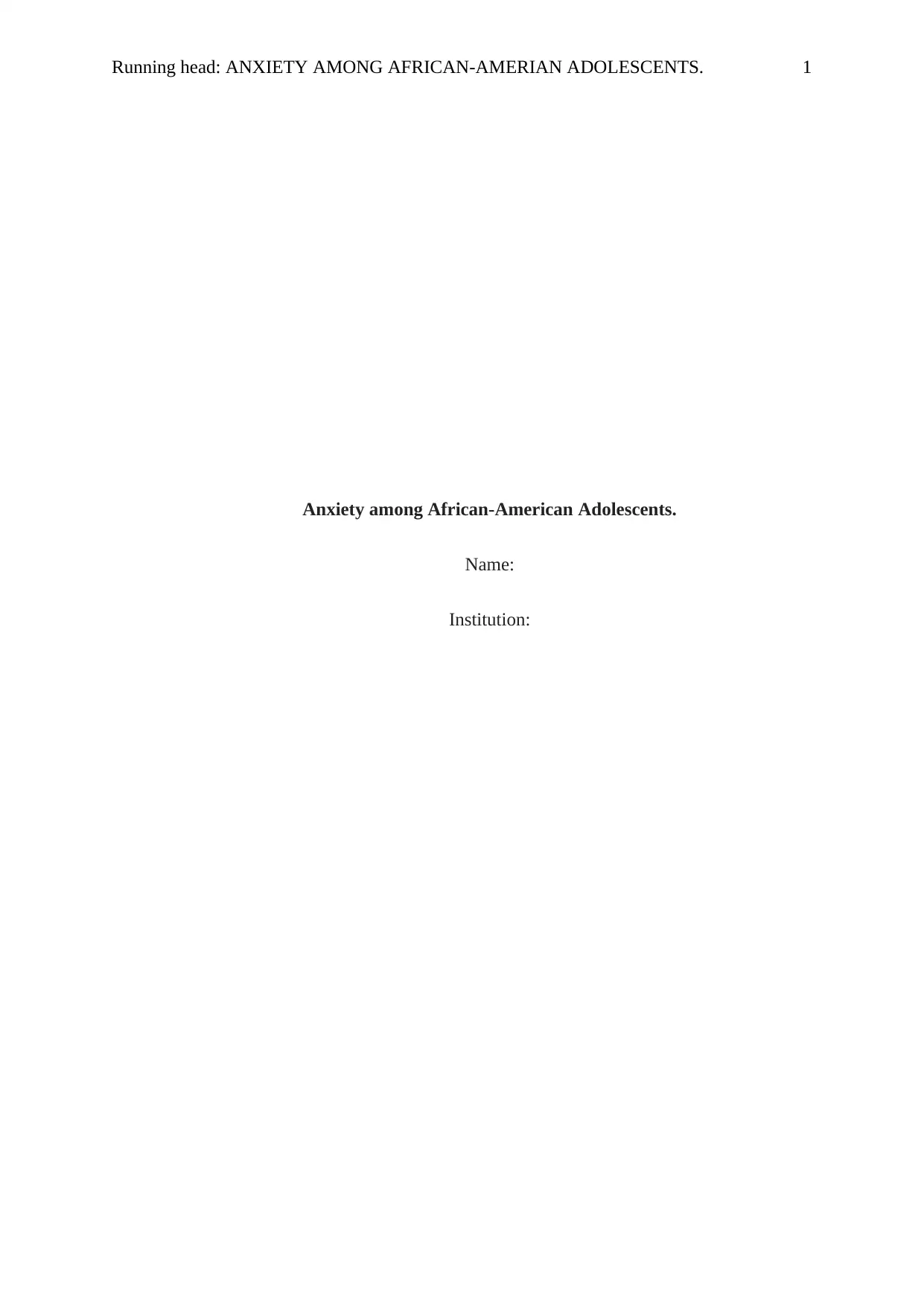
Running head: ANXIETY AMONG AFRICAN-AMERIAN ADOLESCENTS. 1
Anxiety among African-American Adolescents.
Name:
Institution:
Anxiety among African-American Adolescents.
Name:
Institution:
Secure Best Marks with AI Grader
Need help grading? Try our AI Grader for instant feedback on your assignments.
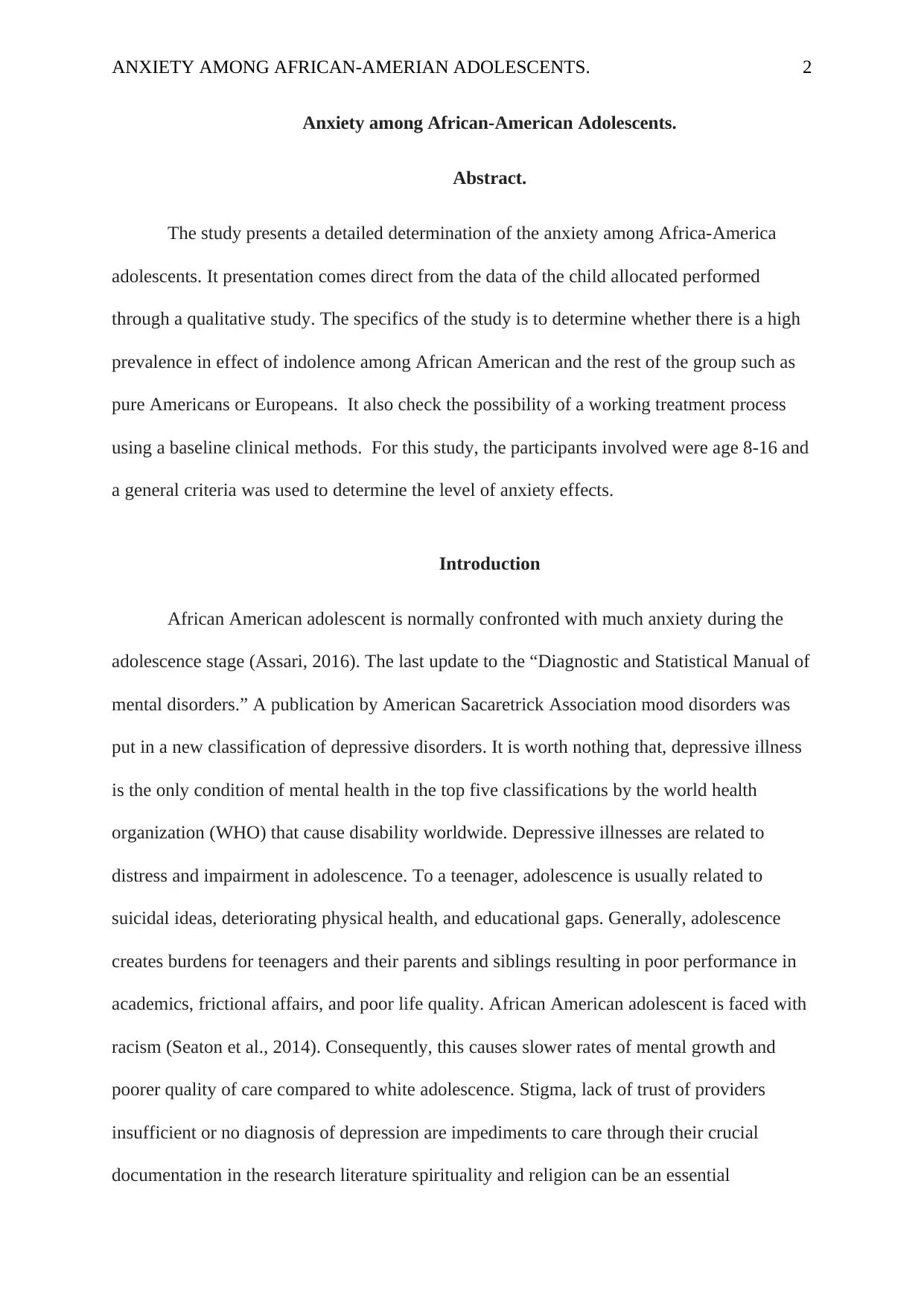
ANXIETY AMONG AFRICAN-AMERIAN ADOLESCENTS. 2
Anxiety among African-American Adolescents.
Abstract.
The study presents a detailed determination of the anxiety among Africa-America
adolescents. It presentation comes direct from the data of the child allocated performed
through a qualitative study. The specifics of the study is to determine whether there is a high
prevalence in effect of indolence among African American and the rest of the group such as
pure Americans or Europeans. It also check the possibility of a working treatment process
using a baseline clinical methods. For this study, the participants involved were age 8-16 and
a general criteria was used to determine the level of anxiety effects.
Introduction
African American adolescent is normally confronted with much anxiety during the
adolescence stage (Assari, 2016). The last update to the “Diagnostic and Statistical Manual of
mental disorders.” A publication by American Sacaretrick Association mood disorders was
put in a new classification of depressive disorders. It is worth nothing that, depressive illness
is the only condition of mental health in the top five classifications by the world health
organization (WHO) that cause disability worldwide. Depressive illnesses are related to
distress and impairment in adolescence. To a teenager, adolescence is usually related to
suicidal ideas, deteriorating physical health, and educational gaps. Generally, adolescence
creates burdens for teenagers and their parents and siblings resulting in poor performance in
academics, frictional affairs, and poor life quality. African American adolescent is faced with
racism (Seaton et al., 2014). Consequently, this causes slower rates of mental growth and
poorer quality of care compared to white adolescence. Stigma, lack of trust of providers
insufficient or no diagnosis of depression are impediments to care through their crucial
documentation in the research literature spirituality and religion can be an essential
Anxiety among African-American Adolescents.
Abstract.
The study presents a detailed determination of the anxiety among Africa-America
adolescents. It presentation comes direct from the data of the child allocated performed
through a qualitative study. The specifics of the study is to determine whether there is a high
prevalence in effect of indolence among African American and the rest of the group such as
pure Americans or Europeans. It also check the possibility of a working treatment process
using a baseline clinical methods. For this study, the participants involved were age 8-16 and
a general criteria was used to determine the level of anxiety effects.
Introduction
African American adolescent is normally confronted with much anxiety during the
adolescence stage (Assari, 2016). The last update to the “Diagnostic and Statistical Manual of
mental disorders.” A publication by American Sacaretrick Association mood disorders was
put in a new classification of depressive disorders. It is worth nothing that, depressive illness
is the only condition of mental health in the top five classifications by the world health
organization (WHO) that cause disability worldwide. Depressive illnesses are related to
distress and impairment in adolescence. To a teenager, adolescence is usually related to
suicidal ideas, deteriorating physical health, and educational gaps. Generally, adolescence
creates burdens for teenagers and their parents and siblings resulting in poor performance in
academics, frictional affairs, and poor life quality. African American adolescent is faced with
racism (Seaton et al., 2014). Consequently, this causes slower rates of mental growth and
poorer quality of care compared to white adolescence. Stigma, lack of trust of providers
insufficient or no diagnosis of depression are impediments to care through their crucial
documentation in the research literature spirituality and religion can be an essential
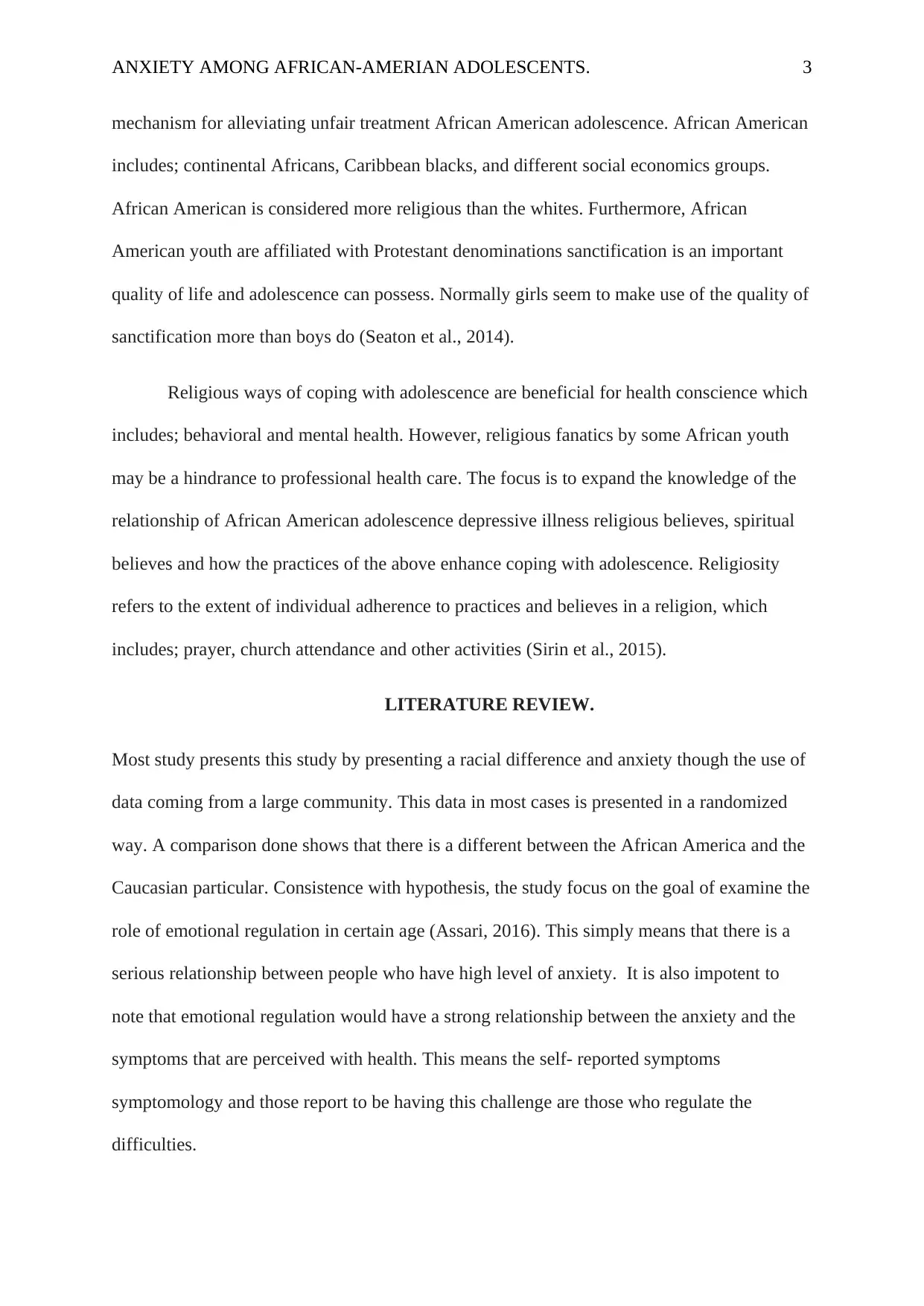
ANXIETY AMONG AFRICAN-AMERIAN ADOLESCENTS. 3
mechanism for alleviating unfair treatment African American adolescence. African American
includes; continental Africans, Caribbean blacks, and different social economics groups.
African American is considered more religious than the whites. Furthermore, African
American youth are affiliated with Protestant denominations sanctification is an important
quality of life and adolescence can possess. Normally girls seem to make use of the quality of
sanctification more than boys do (Seaton et al., 2014).
Religious ways of coping with adolescence are beneficial for health conscience which
includes; behavioral and mental health. However, religious fanatics by some African youth
may be a hindrance to professional health care. The focus is to expand the knowledge of the
relationship of African American adolescence depressive illness religious believes, spiritual
believes and how the practices of the above enhance coping with adolescence. Religiosity
refers to the extent of individual adherence to practices and believes in a religion, which
includes; prayer, church attendance and other activities (Sirin et al., 2015).
LITERATURE REVIEW.
Most study presents this study by presenting a racial difference and anxiety though the use of
data coming from a large community. This data in most cases is presented in a randomized
way. A comparison done shows that there is a different between the African America and the
Caucasian particular. Consistence with hypothesis, the study focus on the goal of examine the
role of emotional regulation in certain age (Assari, 2016). This simply means that there is a
serious relationship between people who have high level of anxiety. It is also impotent to
note that emotional regulation would have a strong relationship between the anxiety and the
symptoms that are perceived with health. This means the self- reported symptoms
symptomology and those report to be having this challenge are those who regulate the
difficulties.
mechanism for alleviating unfair treatment African American adolescence. African American
includes; continental Africans, Caribbean blacks, and different social economics groups.
African American is considered more religious than the whites. Furthermore, African
American youth are affiliated with Protestant denominations sanctification is an important
quality of life and adolescence can possess. Normally girls seem to make use of the quality of
sanctification more than boys do (Seaton et al., 2014).
Religious ways of coping with adolescence are beneficial for health conscience which
includes; behavioral and mental health. However, religious fanatics by some African youth
may be a hindrance to professional health care. The focus is to expand the knowledge of the
relationship of African American adolescence depressive illness religious believes, spiritual
believes and how the practices of the above enhance coping with adolescence. Religiosity
refers to the extent of individual adherence to practices and believes in a religion, which
includes; prayer, church attendance and other activities (Sirin et al., 2015).
LITERATURE REVIEW.
Most study presents this study by presenting a racial difference and anxiety though the use of
data coming from a large community. This data in most cases is presented in a randomized
way. A comparison done shows that there is a different between the African America and the
Caucasian particular. Consistence with hypothesis, the study focus on the goal of examine the
role of emotional regulation in certain age (Assari, 2016). This simply means that there is a
serious relationship between people who have high level of anxiety. It is also impotent to
note that emotional regulation would have a strong relationship between the anxiety and the
symptoms that are perceived with health. This means the self- reported symptoms
symptomology and those report to be having this challenge are those who regulate the
difficulties.
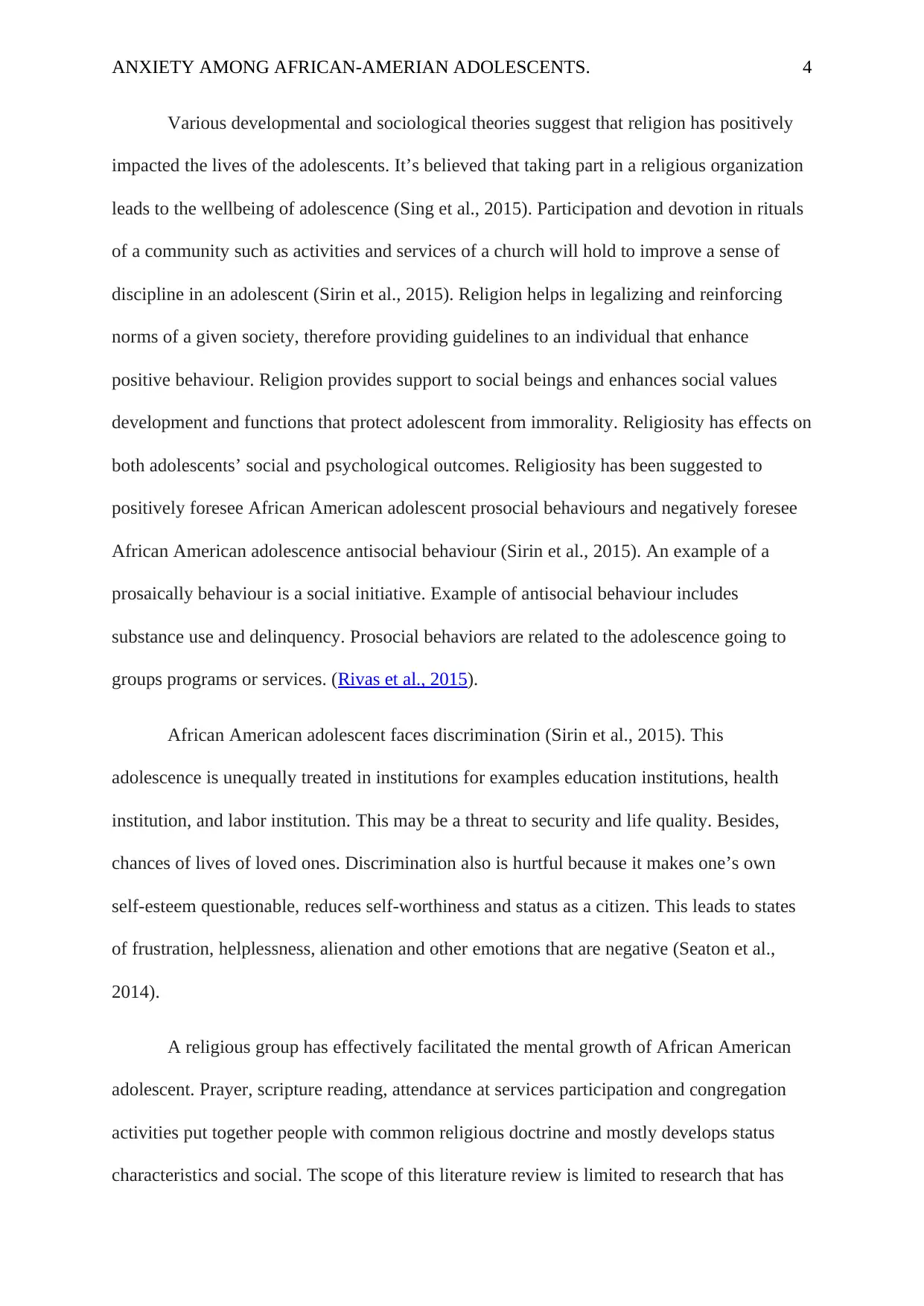
ANXIETY AMONG AFRICAN-AMERIAN ADOLESCENTS. 4
Various developmental and sociological theories suggest that religion has positively
impacted the lives of the adolescents. It’s believed that taking part in a religious organization
leads to the wellbeing of adolescence (Sing et al., 2015). Participation and devotion in rituals
of a community such as activities and services of a church will hold to improve a sense of
discipline in an adolescent (Sirin et al., 2015). Religion helps in legalizing and reinforcing
norms of a given society, therefore providing guidelines to an individual that enhance
positive behaviour. Religion provides support to social beings and enhances social values
development and functions that protect adolescent from immorality. Religiosity has effects on
both adolescents’ social and psychological outcomes. Religiosity has been suggested to
positively foresee African American adolescent prosocial behaviours and negatively foresee
African American adolescence antisocial behaviour (Sirin et al., 2015). An example of a
prosaically behaviour is a social initiative. Example of antisocial behaviour includes
substance use and delinquency. Prosocial behaviors are related to the adolescence going to
groups programs or services. (Rivas et al., 2015).
African American adolescent faces discrimination (Sirin et al., 2015). This
adolescence is unequally treated in institutions for examples education institutions, health
institution, and labor institution. This may be a threat to security and life quality. Besides,
chances of lives of loved ones. Discrimination also is hurtful because it makes one’s own
self-esteem questionable, reduces self-worthiness and status as a citizen. This leads to states
of frustration, helplessness, alienation and other emotions that are negative (Seaton et al.,
2014).
A religious group has effectively facilitated the mental growth of African American
adolescent. Prayer, scripture reading, attendance at services participation and congregation
activities put together people with common religious doctrine and mostly develops status
characteristics and social. The scope of this literature review is limited to research that has
Various developmental and sociological theories suggest that religion has positively
impacted the lives of the adolescents. It’s believed that taking part in a religious organization
leads to the wellbeing of adolescence (Sing et al., 2015). Participation and devotion in rituals
of a community such as activities and services of a church will hold to improve a sense of
discipline in an adolescent (Sirin et al., 2015). Religion helps in legalizing and reinforcing
norms of a given society, therefore providing guidelines to an individual that enhance
positive behaviour. Religion provides support to social beings and enhances social values
development and functions that protect adolescent from immorality. Religiosity has effects on
both adolescents’ social and psychological outcomes. Religiosity has been suggested to
positively foresee African American adolescent prosocial behaviours and negatively foresee
African American adolescence antisocial behaviour (Sirin et al., 2015). An example of a
prosaically behaviour is a social initiative. Example of antisocial behaviour includes
substance use and delinquency. Prosocial behaviors are related to the adolescence going to
groups programs or services. (Rivas et al., 2015).
African American adolescent faces discrimination (Sirin et al., 2015). This
adolescence is unequally treated in institutions for examples education institutions, health
institution, and labor institution. This may be a threat to security and life quality. Besides,
chances of lives of loved ones. Discrimination also is hurtful because it makes one’s own
self-esteem questionable, reduces self-worthiness and status as a citizen. This leads to states
of frustration, helplessness, alienation and other emotions that are negative (Seaton et al.,
2014).
A religious group has effectively facilitated the mental growth of African American
adolescent. Prayer, scripture reading, attendance at services participation and congregation
activities put together people with common religious doctrine and mostly develops status
characteristics and social. The scope of this literature review is limited to research that has
Secure Best Marks with AI Grader
Need help grading? Try our AI Grader for instant feedback on your assignments.
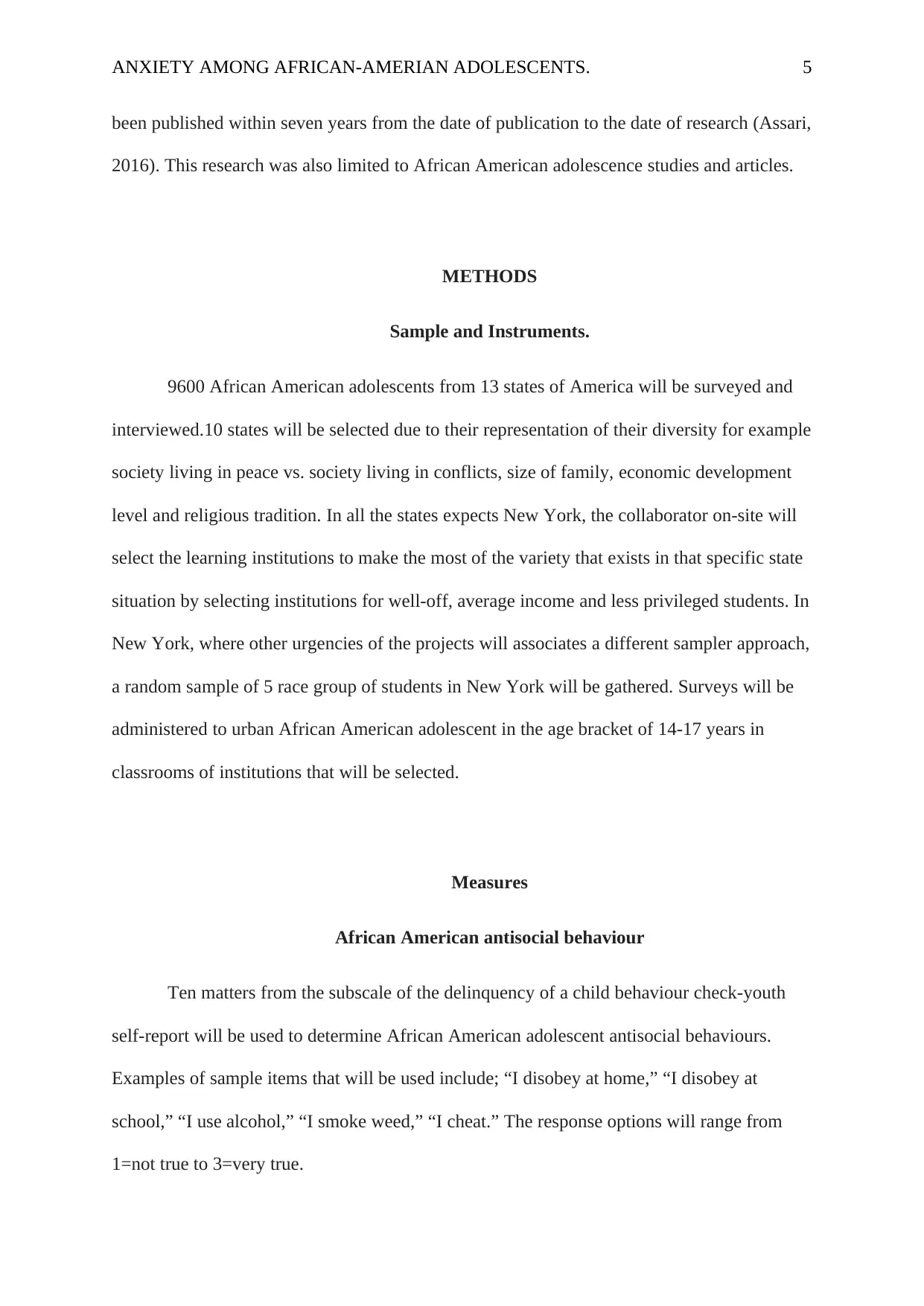
ANXIETY AMONG AFRICAN-AMERIAN ADOLESCENTS. 5
been published within seven years from the date of publication to the date of research (Assari,
2016). This research was also limited to African American adolescence studies and articles.
METHODS
Sample and Instruments.
9600 African American adolescents from 13 states of America will be surveyed and
interviewed.10 states will be selected due to their representation of their diversity for example
society living in peace vs. society living in conflicts, size of family, economic development
level and religious tradition. In all the states expects New York, the collaborator on-site will
select the learning institutions to make the most of the variety that exists in that specific state
situation by selecting institutions for well-off, average income and less privileged students. In
New York, where other urgencies of the projects will associates a different sampler approach,
a random sample of 5 race group of students in New York will be gathered. Surveys will be
administered to urban African American adolescent in the age bracket of 14-17 years in
classrooms of institutions that will be selected.
Measures
African American antisocial behaviour
Ten matters from the subscale of the delinquency of a child behaviour check-youth
self-report will be used to determine African American adolescent antisocial behaviours.
Examples of sample items that will be used include; “I disobey at home,” “I disobey at
school,” “I use alcohol,” “I smoke weed,” “I cheat.” The response options will range from
1=not true to 3=very true.
been published within seven years from the date of publication to the date of research (Assari,
2016). This research was also limited to African American adolescence studies and articles.
METHODS
Sample and Instruments.
9600 African American adolescents from 13 states of America will be surveyed and
interviewed.10 states will be selected due to their representation of their diversity for example
society living in peace vs. society living in conflicts, size of family, economic development
level and religious tradition. In all the states expects New York, the collaborator on-site will
select the learning institutions to make the most of the variety that exists in that specific state
situation by selecting institutions for well-off, average income and less privileged students. In
New York, where other urgencies of the projects will associates a different sampler approach,
a random sample of 5 race group of students in New York will be gathered. Surveys will be
administered to urban African American adolescent in the age bracket of 14-17 years in
classrooms of institutions that will be selected.
Measures
African American antisocial behaviour
Ten matters from the subscale of the delinquency of a child behaviour check-youth
self-report will be used to determine African American adolescent antisocial behaviours.
Examples of sample items that will be used include; “I disobey at home,” “I disobey at
school,” “I use alcohol,” “I smoke weed,” “I cheat.” The response options will range from
1=not true to 3=very true.
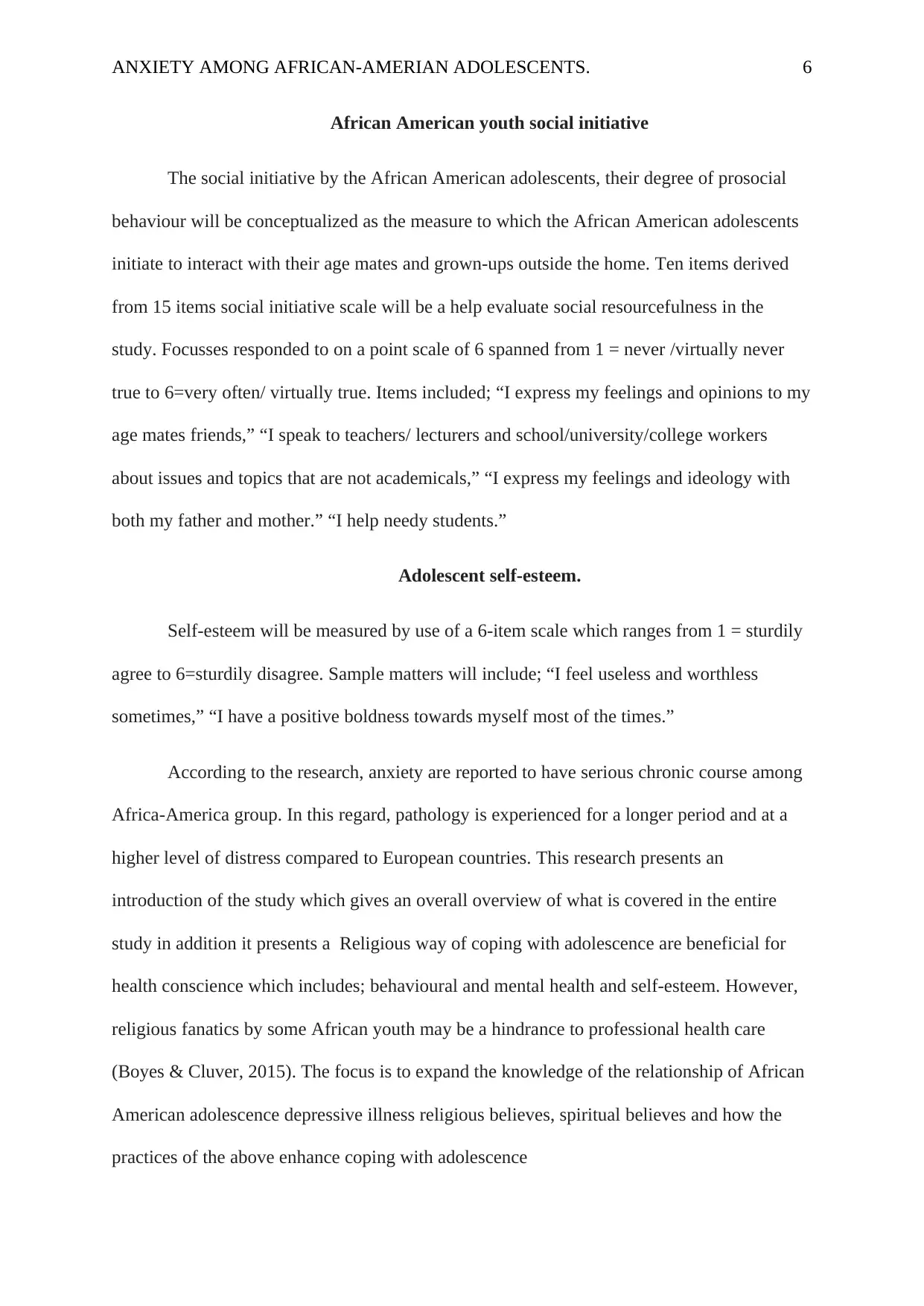
ANXIETY AMONG AFRICAN-AMERIAN ADOLESCENTS. 6
African American youth social initiative
The social initiative by the African American adolescents, their degree of prosocial
behaviour will be conceptualized as the measure to which the African American adolescents
initiate to interact with their age mates and grown-ups outside the home. Ten items derived
from 15 items social initiative scale will be a help evaluate social resourcefulness in the
study. Focusses responded to on a point scale of 6 spanned from 1 = never /virtually never
true to 6=very often/ virtually true. Items included; “I express my feelings and opinions to my
age mates friends,” “I speak to teachers/ lecturers and school/university/college workers
about issues and topics that are not academicals,” “I express my feelings and ideology with
both my father and mother.” “I help needy students.”
Adolescent self-esteem.
Self-esteem will be measured by use of a 6-item scale which ranges from 1 = sturdily
agree to 6=sturdily disagree. Sample matters will include; “I feel useless and worthless
sometimes,” “I have a positive boldness towards myself most of the times.”
According to the research, anxiety are reported to have serious chronic course among
Africa-America group. In this regard, pathology is experienced for a longer period and at a
higher level of distress compared to European countries. This research presents an
introduction of the study which gives an overall overview of what is covered in the entire
study in addition it presents a Religious way of coping with adolescence are beneficial for
health conscience which includes; behavioural and mental health and self-esteem. However,
religious fanatics by some African youth may be a hindrance to professional health care
(Boyes & Cluver, 2015). The focus is to expand the knowledge of the relationship of African
American adolescence depressive illness religious believes, spiritual believes and how the
practices of the above enhance coping with adolescence
African American youth social initiative
The social initiative by the African American adolescents, their degree of prosocial
behaviour will be conceptualized as the measure to which the African American adolescents
initiate to interact with their age mates and grown-ups outside the home. Ten items derived
from 15 items social initiative scale will be a help evaluate social resourcefulness in the
study. Focusses responded to on a point scale of 6 spanned from 1 = never /virtually never
true to 6=very often/ virtually true. Items included; “I express my feelings and opinions to my
age mates friends,” “I speak to teachers/ lecturers and school/university/college workers
about issues and topics that are not academicals,” “I express my feelings and ideology with
both my father and mother.” “I help needy students.”
Adolescent self-esteem.
Self-esteem will be measured by use of a 6-item scale which ranges from 1 = sturdily
agree to 6=sturdily disagree. Sample matters will include; “I feel useless and worthless
sometimes,” “I have a positive boldness towards myself most of the times.”
According to the research, anxiety are reported to have serious chronic course among
Africa-America group. In this regard, pathology is experienced for a longer period and at a
higher level of distress compared to European countries. This research presents an
introduction of the study which gives an overall overview of what is covered in the entire
study in addition it presents a Religious way of coping with adolescence are beneficial for
health conscience which includes; behavioural and mental health and self-esteem. However,
religious fanatics by some African youth may be a hindrance to professional health care
(Boyes & Cluver, 2015). The focus is to expand the knowledge of the relationship of African
American adolescence depressive illness religious believes, spiritual believes and how the
practices of the above enhance coping with adolescence
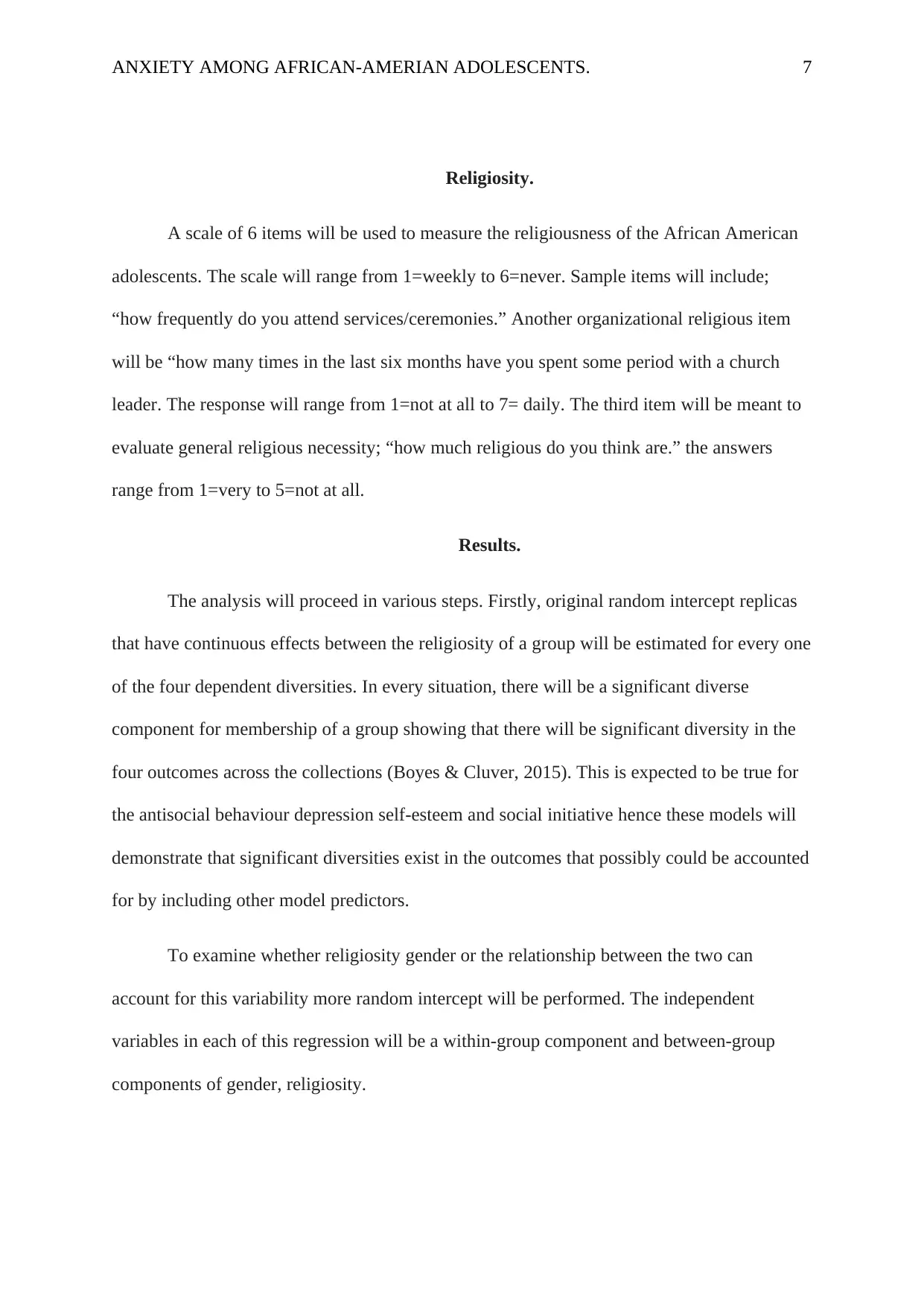
ANXIETY AMONG AFRICAN-AMERIAN ADOLESCENTS. 7
Religiosity.
A scale of 6 items will be used to measure the religiousness of the African American
adolescents. The scale will range from 1=weekly to 6=never. Sample items will include;
“how frequently do you attend services/ceremonies.” Another organizational religious item
will be “how many times in the last six months have you spent some period with a church
leader. The response will range from 1=not at all to 7= daily. The third item will be meant to
evaluate general religious necessity; “how much religious do you think are.” the answers
range from 1=very to 5=not at all.
Results.
The analysis will proceed in various steps. Firstly, original random intercept replicas
that have continuous effects between the religiosity of a group will be estimated for every one
of the four dependent diversities. In every situation, there will be a significant diverse
component for membership of a group showing that there will be significant diversity in the
four outcomes across the collections (Boyes & Cluver, 2015). This is expected to be true for
the antisocial behaviour depression self-esteem and social initiative hence these models will
demonstrate that significant diversities exist in the outcomes that possibly could be accounted
for by including other model predictors.
To examine whether religiosity gender or the relationship between the two can
account for this variability more random intercept will be performed. The independent
variables in each of this regression will be a within-group component and between-group
components of gender, religiosity.
Religiosity.
A scale of 6 items will be used to measure the religiousness of the African American
adolescents. The scale will range from 1=weekly to 6=never. Sample items will include;
“how frequently do you attend services/ceremonies.” Another organizational religious item
will be “how many times in the last six months have you spent some period with a church
leader. The response will range from 1=not at all to 7= daily. The third item will be meant to
evaluate general religious necessity; “how much religious do you think are.” the answers
range from 1=very to 5=not at all.
Results.
The analysis will proceed in various steps. Firstly, original random intercept replicas
that have continuous effects between the religiosity of a group will be estimated for every one
of the four dependent diversities. In every situation, there will be a significant diverse
component for membership of a group showing that there will be significant diversity in the
four outcomes across the collections (Boyes & Cluver, 2015). This is expected to be true for
the antisocial behaviour depression self-esteem and social initiative hence these models will
demonstrate that significant diversities exist in the outcomes that possibly could be accounted
for by including other model predictors.
To examine whether religiosity gender or the relationship between the two can
account for this variability more random intercept will be performed. The independent
variables in each of this regression will be a within-group component and between-group
components of gender, religiosity.
Paraphrase This Document
Need a fresh take? Get an instant paraphrase of this document with our AI Paraphraser
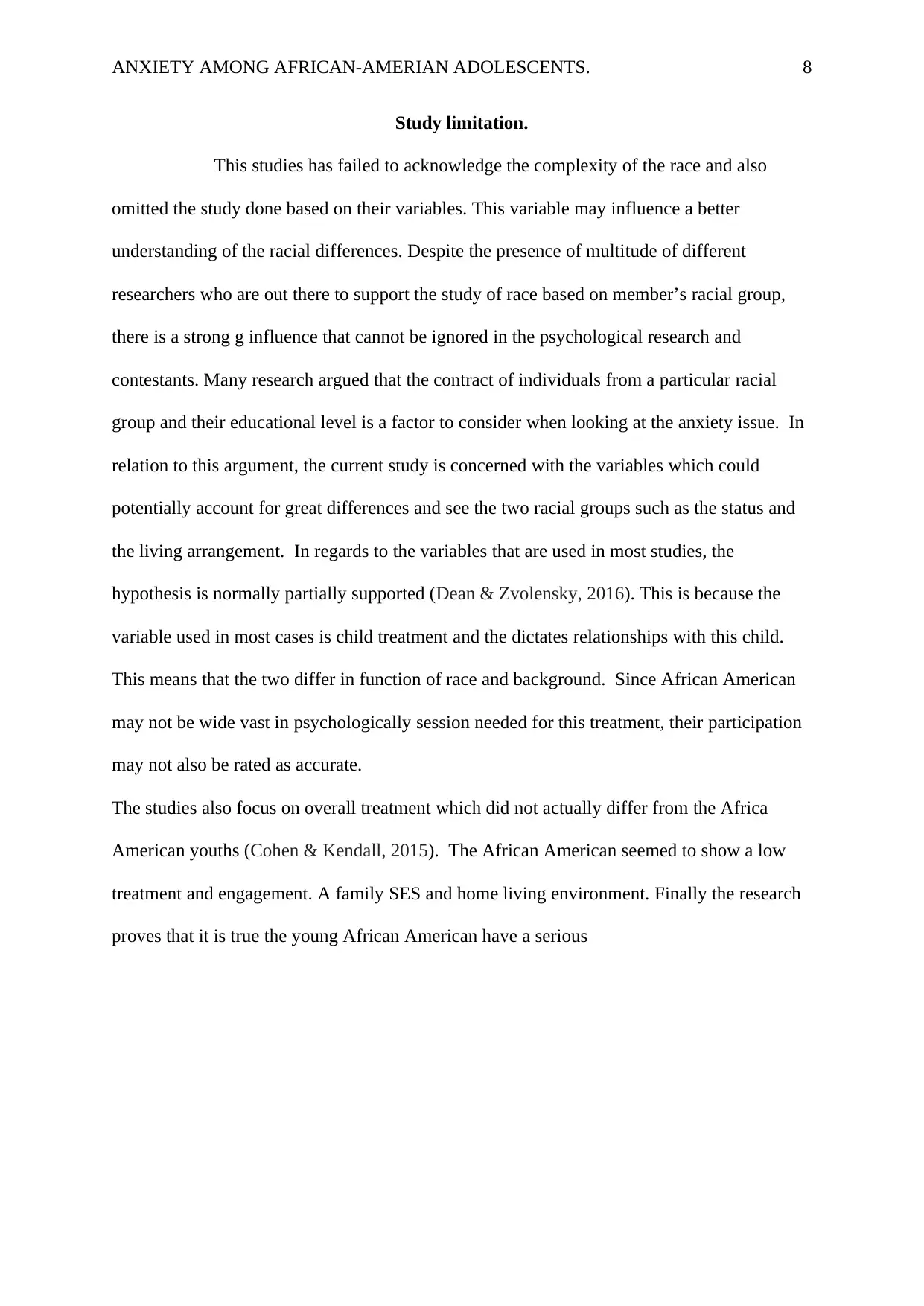
ANXIETY AMONG AFRICAN-AMERIAN ADOLESCENTS. 8
Study limitation.
This studies has failed to acknowledge the complexity of the race and also
omitted the study done based on their variables. This variable may influence a better
understanding of the racial differences. Despite the presence of multitude of different
researchers who are out there to support the study of race based on member’s racial group,
there is a strong g influence that cannot be ignored in the psychological research and
contestants. Many research argued that the contract of individuals from a particular racial
group and their educational level is a factor to consider when looking at the anxiety issue. In
relation to this argument, the current study is concerned with the variables which could
potentially account for great differences and see the two racial groups such as the status and
the living arrangement. In regards to the variables that are used in most studies, the
hypothesis is normally partially supported (Dean & Zvolensky, 2016). This is because the
variable used in most cases is child treatment and the dictates relationships with this child.
This means that the two differ in function of race and background. Since African American
may not be wide vast in psychologically session needed for this treatment, their participation
may not also be rated as accurate.
The studies also focus on overall treatment which did not actually differ from the Africa
American youths (Cohen & Kendall, 2015). The African American seemed to show a low
treatment and engagement. A family SES and home living environment. Finally the research
proves that it is true the young African American have a serious
Study limitation.
This studies has failed to acknowledge the complexity of the race and also
omitted the study done based on their variables. This variable may influence a better
understanding of the racial differences. Despite the presence of multitude of different
researchers who are out there to support the study of race based on member’s racial group,
there is a strong g influence that cannot be ignored in the psychological research and
contestants. Many research argued that the contract of individuals from a particular racial
group and their educational level is a factor to consider when looking at the anxiety issue. In
relation to this argument, the current study is concerned with the variables which could
potentially account for great differences and see the two racial groups such as the status and
the living arrangement. In regards to the variables that are used in most studies, the
hypothesis is normally partially supported (Dean & Zvolensky, 2016). This is because the
variable used in most cases is child treatment and the dictates relationships with this child.
This means that the two differ in function of race and background. Since African American
may not be wide vast in psychologically session needed for this treatment, their participation
may not also be rated as accurate.
The studies also focus on overall treatment which did not actually differ from the Africa
American youths (Cohen & Kendall, 2015). The African American seemed to show a low
treatment and engagement. A family SES and home living environment. Finally the research
proves that it is true the young African American have a serious
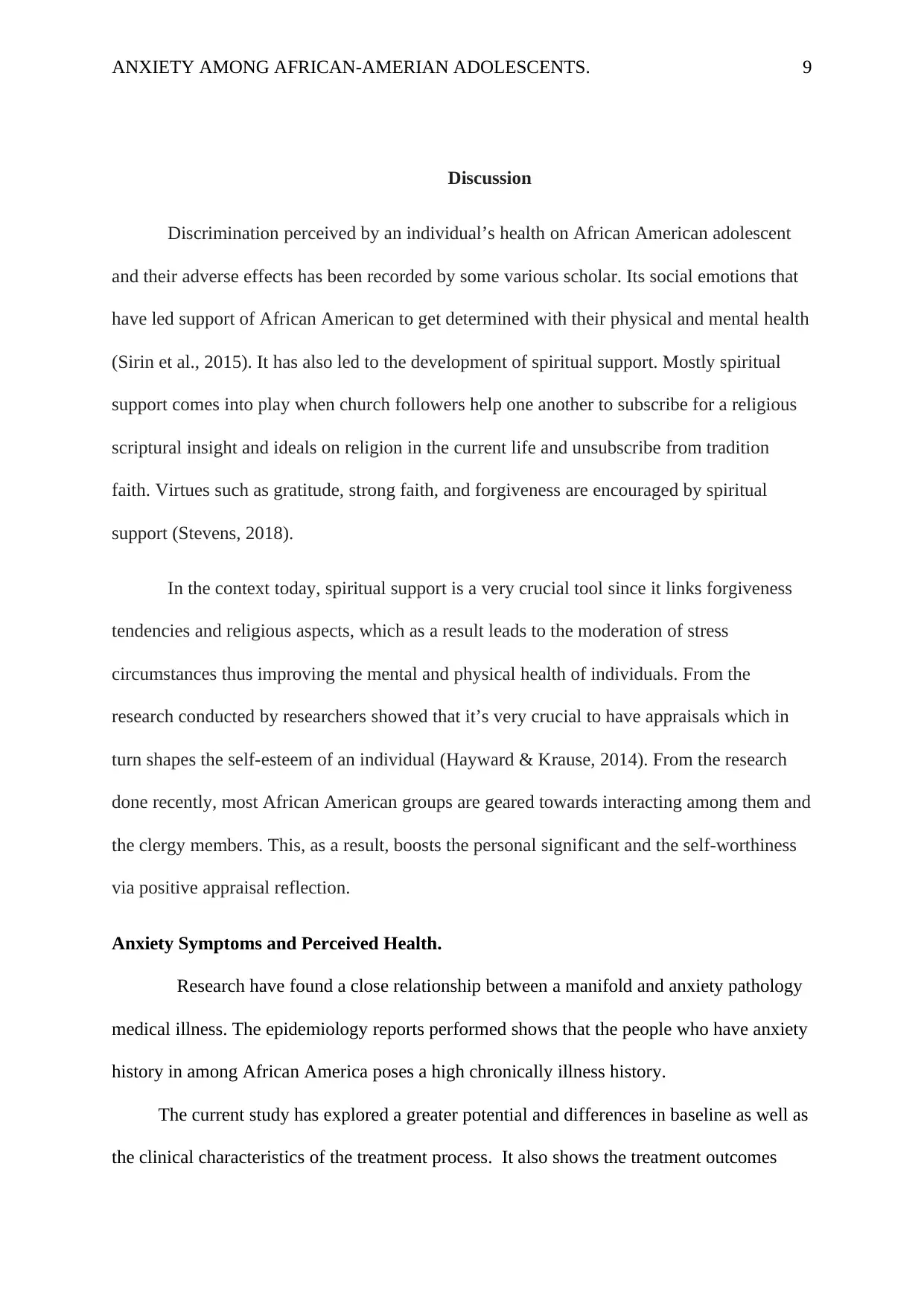
ANXIETY AMONG AFRICAN-AMERIAN ADOLESCENTS. 9
Discussion
Discrimination perceived by an individual’s health on African American adolescent
and their adverse effects has been recorded by some various scholar. Its social emotions that
have led support of African American to get determined with their physical and mental health
(Sirin et al., 2015). It has also led to the development of spiritual support. Mostly spiritual
support comes into play when church followers help one another to subscribe for a religious
scriptural insight and ideals on religion in the current life and unsubscribe from tradition
faith. Virtues such as gratitude, strong faith, and forgiveness are encouraged by spiritual
support (Stevens, 2018).
In the context today, spiritual support is a very crucial tool since it links forgiveness
tendencies and religious aspects, which as a result leads to the moderation of stress
circumstances thus improving the mental and physical health of individuals. From the
research conducted by researchers showed that it’s very crucial to have appraisals which in
turn shapes the self-esteem of an individual (Hayward & Krause, 2014). From the research
done recently, most African American groups are geared towards interacting among them and
the clergy members. This, as a result, boosts the personal significant and the self-worthiness
via positive appraisal reflection.
Anxiety Symptoms and Perceived Health.
Research have found a close relationship between a manifold and anxiety pathology
medical illness. The epidemiology reports performed shows that the people who have anxiety
history in among African America poses a high chronically illness history.
The current study has explored a greater potential and differences in baseline as well as
the clinical characteristics of the treatment process. It also shows the treatment outcomes
Discussion
Discrimination perceived by an individual’s health on African American adolescent
and their adverse effects has been recorded by some various scholar. Its social emotions that
have led support of African American to get determined with their physical and mental health
(Sirin et al., 2015). It has also led to the development of spiritual support. Mostly spiritual
support comes into play when church followers help one another to subscribe for a religious
scriptural insight and ideals on religion in the current life and unsubscribe from tradition
faith. Virtues such as gratitude, strong faith, and forgiveness are encouraged by spiritual
support (Stevens, 2018).
In the context today, spiritual support is a very crucial tool since it links forgiveness
tendencies and religious aspects, which as a result leads to the moderation of stress
circumstances thus improving the mental and physical health of individuals. From the
research conducted by researchers showed that it’s very crucial to have appraisals which in
turn shapes the self-esteem of an individual (Hayward & Krause, 2014). From the research
done recently, most African American groups are geared towards interacting among them and
the clergy members. This, as a result, boosts the personal significant and the self-worthiness
via positive appraisal reflection.
Anxiety Symptoms and Perceived Health.
Research have found a close relationship between a manifold and anxiety pathology
medical illness. The epidemiology reports performed shows that the people who have anxiety
history in among African America poses a high chronically illness history.
The current study has explored a greater potential and differences in baseline as well as
the clinical characteristics of the treatment process. It also shows the treatment outcomes
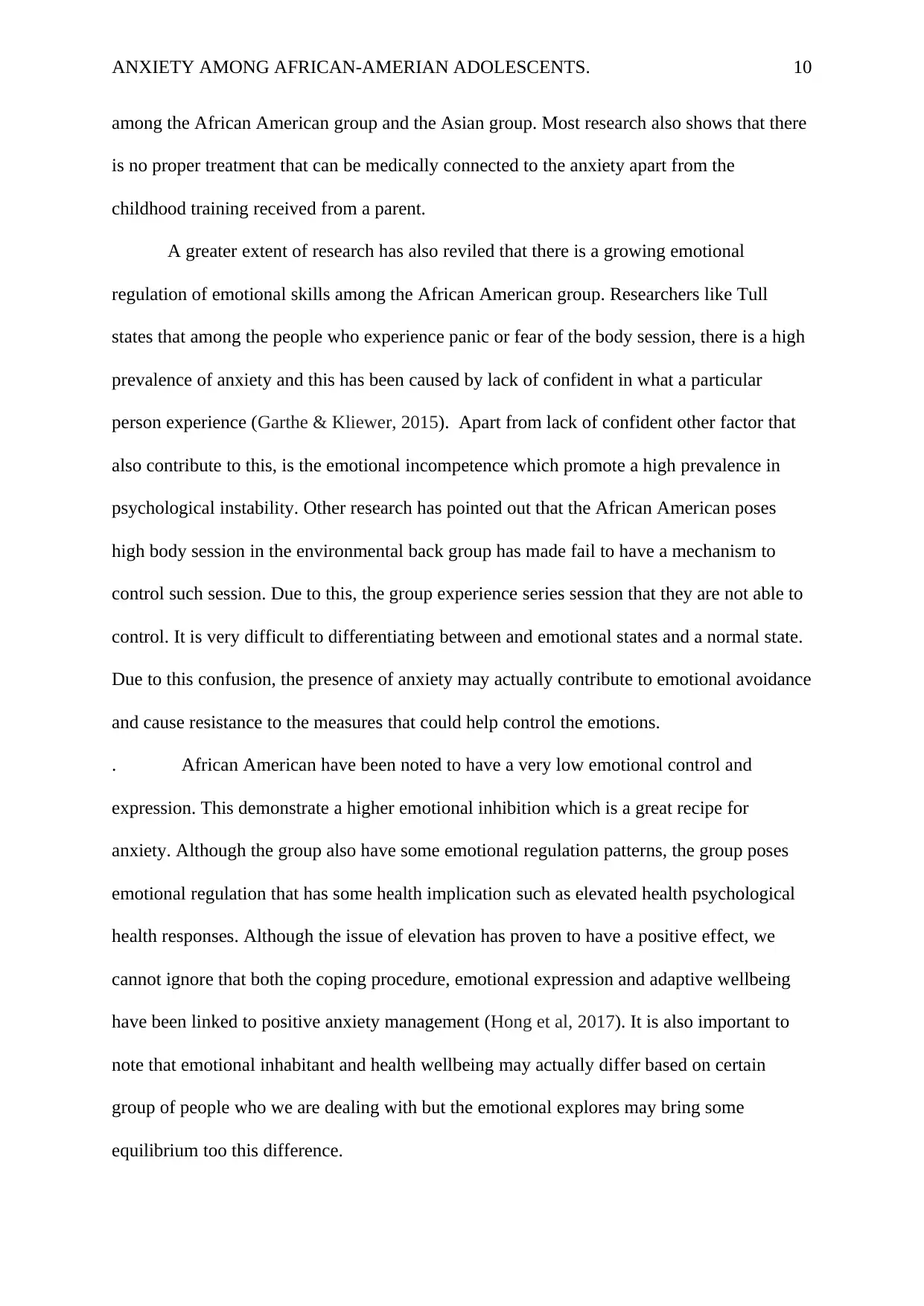
ANXIETY AMONG AFRICAN-AMERIAN ADOLESCENTS. 10
among the African American group and the Asian group. Most research also shows that there
is no proper treatment that can be medically connected to the anxiety apart from the
childhood training received from a parent.
A greater extent of research has also reviled that there is a growing emotional
regulation of emotional skills among the African American group. Researchers like Tull
states that among the people who experience panic or fear of the body session, there is a high
prevalence of anxiety and this has been caused by lack of confident in what a particular
person experience (Garthe & Kliewer, 2015). Apart from lack of confident other factor that
also contribute to this, is the emotional incompetence which promote a high prevalence in
psychological instability. Other research has pointed out that the African American poses
high body session in the environmental back group has made fail to have a mechanism to
control such session. Due to this, the group experience series session that they are not able to
control. It is very difficult to differentiating between and emotional states and a normal state.
Due to this confusion, the presence of anxiety may actually contribute to emotional avoidance
and cause resistance to the measures that could help control the emotions.
. African American have been noted to have a very low emotional control and
expression. This demonstrate a higher emotional inhibition which is a great recipe for
anxiety. Although the group also have some emotional regulation patterns, the group poses
emotional regulation that has some health implication such as elevated health psychological
health responses. Although the issue of elevation has proven to have a positive effect, we
cannot ignore that both the coping procedure, emotional expression and adaptive wellbeing
have been linked to positive anxiety management (Hong et al, 2017). It is also important to
note that emotional inhabitant and health wellbeing may actually differ based on certain
group of people who we are dealing with but the emotional explores may bring some
equilibrium too this difference.
among the African American group and the Asian group. Most research also shows that there
is no proper treatment that can be medically connected to the anxiety apart from the
childhood training received from a parent.
A greater extent of research has also reviled that there is a growing emotional
regulation of emotional skills among the African American group. Researchers like Tull
states that among the people who experience panic or fear of the body session, there is a high
prevalence of anxiety and this has been caused by lack of confident in what a particular
person experience (Garthe & Kliewer, 2015). Apart from lack of confident other factor that
also contribute to this, is the emotional incompetence which promote a high prevalence in
psychological instability. Other research has pointed out that the African American poses
high body session in the environmental back group has made fail to have a mechanism to
control such session. Due to this, the group experience series session that they are not able to
control. It is very difficult to differentiating between and emotional states and a normal state.
Due to this confusion, the presence of anxiety may actually contribute to emotional avoidance
and cause resistance to the measures that could help control the emotions.
. African American have been noted to have a very low emotional control and
expression. This demonstrate a higher emotional inhibition which is a great recipe for
anxiety. Although the group also have some emotional regulation patterns, the group poses
emotional regulation that has some health implication such as elevated health psychological
health responses. Although the issue of elevation has proven to have a positive effect, we
cannot ignore that both the coping procedure, emotional expression and adaptive wellbeing
have been linked to positive anxiety management (Hong et al, 2017). It is also important to
note that emotional inhabitant and health wellbeing may actually differ based on certain
group of people who we are dealing with but the emotional explores may bring some
equilibrium too this difference.
Secure Best Marks with AI Grader
Need help grading? Try our AI Grader for instant feedback on your assignments.
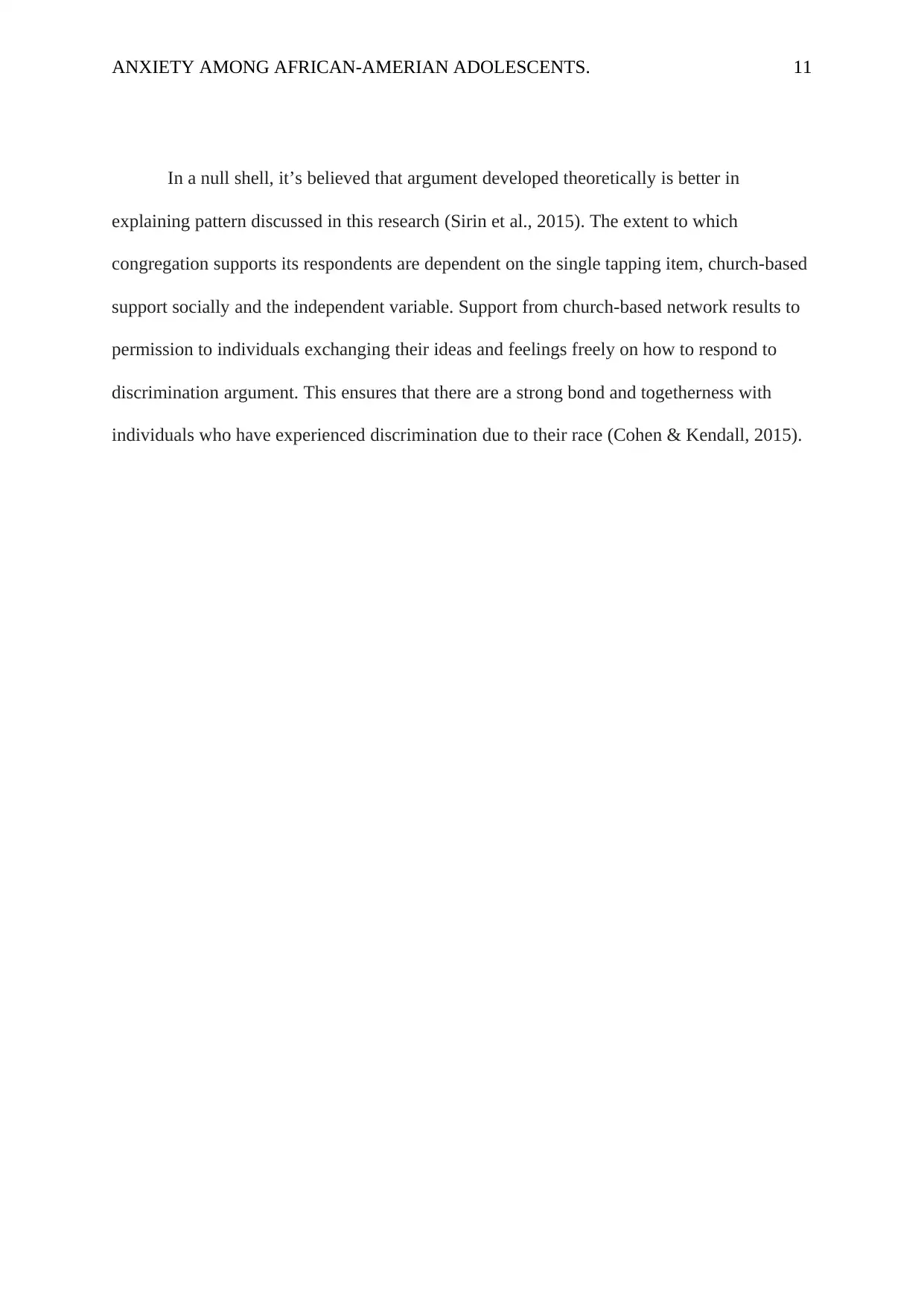
ANXIETY AMONG AFRICAN-AMERIAN ADOLESCENTS. 11
In a null shell, it’s believed that argument developed theoretically is better in
explaining pattern discussed in this research (Sirin et al., 2015). The extent to which
congregation supports its respondents are dependent on the single tapping item, church-based
support socially and the independent variable. Support from church-based network results to
permission to individuals exchanging their ideas and feelings freely on how to respond to
discrimination argument. This ensures that there are a strong bond and togetherness with
individuals who have experienced discrimination due to their race (Cohen & Kendall, 2015).
In a null shell, it’s believed that argument developed theoretically is better in
explaining pattern discussed in this research (Sirin et al., 2015). The extent to which
congregation supports its respondents are dependent on the single tapping item, church-based
support socially and the independent variable. Support from church-based network results to
permission to individuals exchanging their ideas and feelings freely on how to respond to
discrimination argument. This ensures that there are a strong bond and togetherness with
individuals who have experienced discrimination due to their race (Cohen & Kendall, 2015).
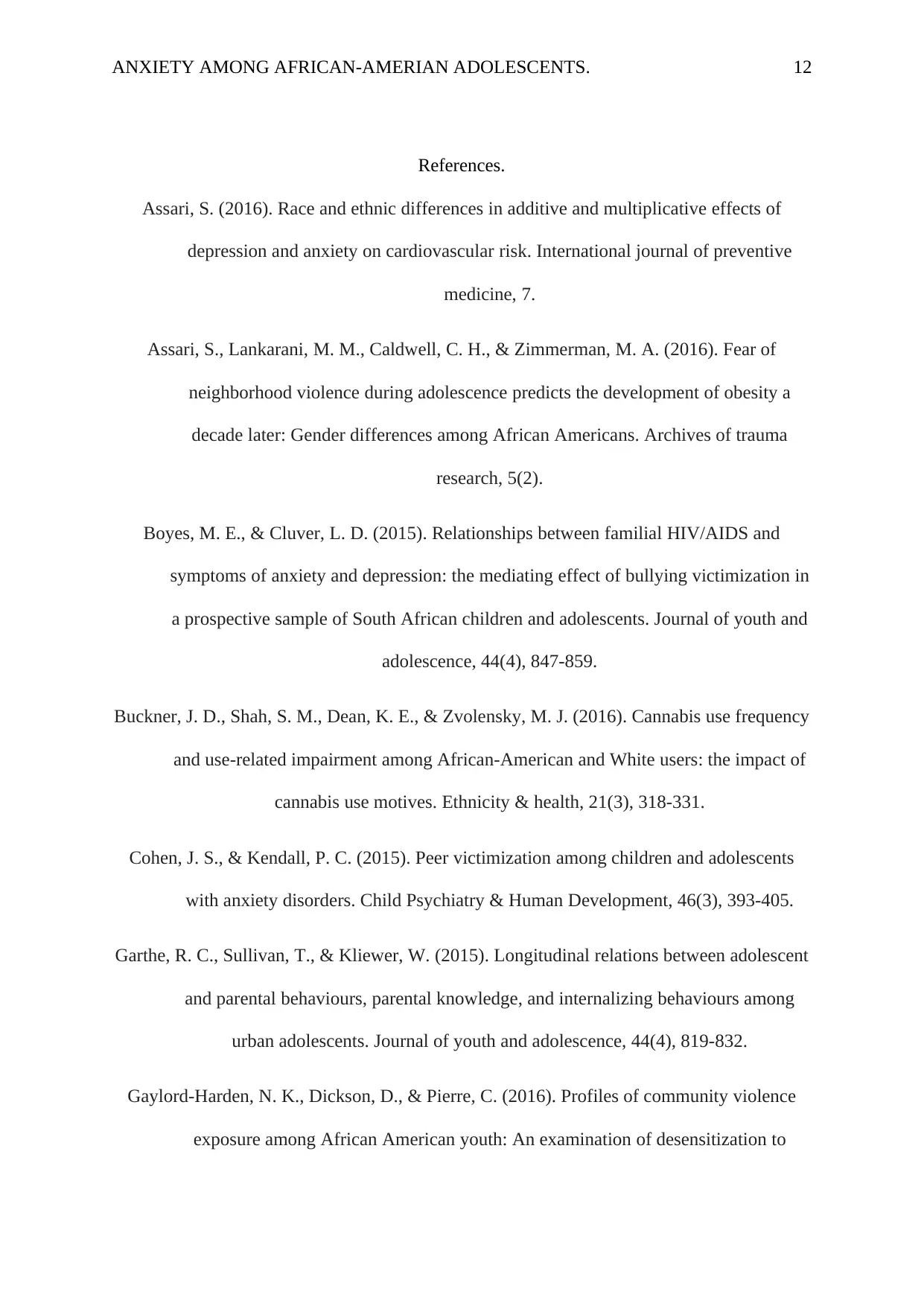
ANXIETY AMONG AFRICAN-AMERIAN ADOLESCENTS. 12
References.
Assari, S. (2016). Race and ethnic differences in additive and multiplicative effects of
depression and anxiety on cardiovascular risk. International journal of preventive
medicine, 7.
Assari, S., Lankarani, M. M., Caldwell, C. H., & Zimmerman, M. A. (2016). Fear of
neighborhood violence during adolescence predicts the development of obesity a
decade later: Gender differences among African Americans. Archives of trauma
research, 5(2).
Boyes, M. E., & Cluver, L. D. (2015). Relationships between familial HIV/AIDS and
symptoms of anxiety and depression: the mediating effect of bullying victimization in
a prospective sample of South African children and adolescents. Journal of youth and
adolescence, 44(4), 847-859.
Buckner, J. D., Shah, S. M., Dean, K. E., & Zvolensky, M. J. (2016). Cannabis use frequency
and use-related impairment among African-American and White users: the impact of
cannabis use motives. Ethnicity & health, 21(3), 318-331.
Cohen, J. S., & Kendall, P. C. (2015). Peer victimization among children and adolescents
with anxiety disorders. Child Psychiatry & Human Development, 46(3), 393-405.
Garthe, R. C., Sullivan, T., & Kliewer, W. (2015). Longitudinal relations between adolescent
and parental behaviours, parental knowledge, and internalizing behaviours among
urban adolescents. Journal of youth and adolescence, 44(4), 819-832.
Gaylord-Harden, N. K., Dickson, D., & Pierre, C. (2016). Profiles of community violence
exposure among African American youth: An examination of desensitization to
References.
Assari, S. (2016). Race and ethnic differences in additive and multiplicative effects of
depression and anxiety on cardiovascular risk. International journal of preventive
medicine, 7.
Assari, S., Lankarani, M. M., Caldwell, C. H., & Zimmerman, M. A. (2016). Fear of
neighborhood violence during adolescence predicts the development of obesity a
decade later: Gender differences among African Americans. Archives of trauma
research, 5(2).
Boyes, M. E., & Cluver, L. D. (2015). Relationships between familial HIV/AIDS and
symptoms of anxiety and depression: the mediating effect of bullying victimization in
a prospective sample of South African children and adolescents. Journal of youth and
adolescence, 44(4), 847-859.
Buckner, J. D., Shah, S. M., Dean, K. E., & Zvolensky, M. J. (2016). Cannabis use frequency
and use-related impairment among African-American and White users: the impact of
cannabis use motives. Ethnicity & health, 21(3), 318-331.
Cohen, J. S., & Kendall, P. C. (2015). Peer victimization among children and adolescents
with anxiety disorders. Child Psychiatry & Human Development, 46(3), 393-405.
Garthe, R. C., Sullivan, T., & Kliewer, W. (2015). Longitudinal relations between adolescent
and parental behaviours, parental knowledge, and internalizing behaviours among
urban adolescents. Journal of youth and adolescence, 44(4), 819-832.
Gaylord-Harden, N. K., Dickson, D., & Pierre, C. (2016). Profiles of community violence
exposure among African American youth: An examination of desensitization to
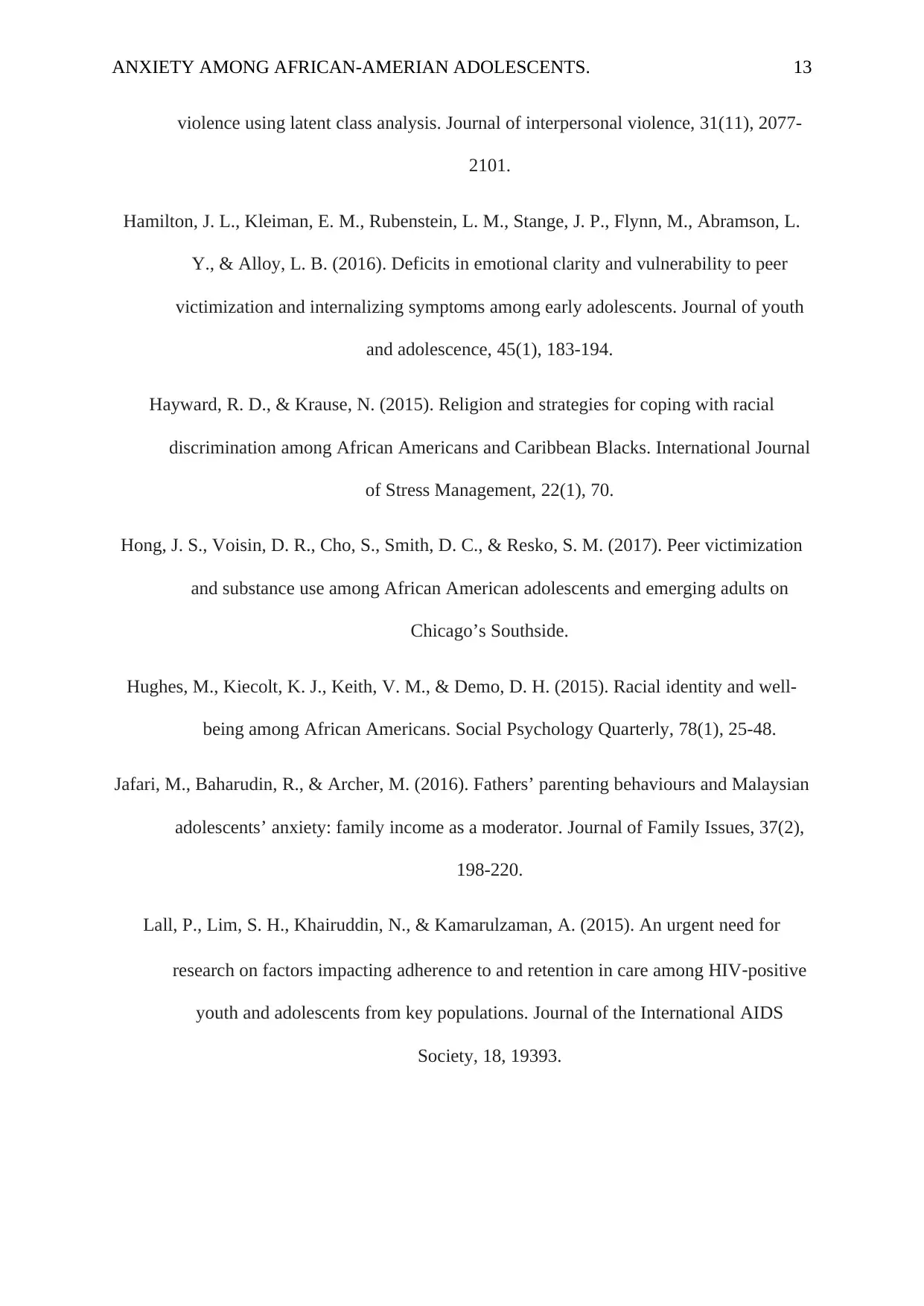
ANXIETY AMONG AFRICAN-AMERIAN ADOLESCENTS. 13
violence using latent class analysis. Journal of interpersonal violence, 31(11), 2077-
2101.
Hamilton, J. L., Kleiman, E. M., Rubenstein, L. M., Stange, J. P., Flynn, M., Abramson, L.
Y., & Alloy, L. B. (2016). Deficits in emotional clarity and vulnerability to peer
victimization and internalizing symptoms among early adolescents. Journal of youth
and adolescence, 45(1), 183-194.
Hayward, R. D., & Krause, N. (2015). Religion and strategies for coping with racial
discrimination among African Americans and Caribbean Blacks. International Journal
of Stress Management, 22(1), 70.
Hong, J. S., Voisin, D. R., Cho, S., Smith, D. C., & Resko, S. M. (2017). Peer victimization
and substance use among African American adolescents and emerging adults on
Chicago’s Southside.
Hughes, M., Kiecolt, K. J., Keith, V. M., & Demo, D. H. (2015). Racial identity and well-
being among African Americans. Social Psychology Quarterly, 78(1), 25-48.
Jafari, M., Baharudin, R., & Archer, M. (2016). Fathers’ parenting behaviours and Malaysian
adolescents’ anxiety: family income as a moderator. Journal of Family Issues, 37(2),
198-220.
Lall, P., Lim, S. H., Khairuddin, N., & Kamarulzaman, A. (2015). An urgent need for
research on factors impacting adherence to and retention in care among HIV‐positive
youth and adolescents from key populations. Journal of the International AIDS
Society, 18, 19393.
violence using latent class analysis. Journal of interpersonal violence, 31(11), 2077-
2101.
Hamilton, J. L., Kleiman, E. M., Rubenstein, L. M., Stange, J. P., Flynn, M., Abramson, L.
Y., & Alloy, L. B. (2016). Deficits in emotional clarity and vulnerability to peer
victimization and internalizing symptoms among early adolescents. Journal of youth
and adolescence, 45(1), 183-194.
Hayward, R. D., & Krause, N. (2015). Religion and strategies for coping with racial
discrimination among African Americans and Caribbean Blacks. International Journal
of Stress Management, 22(1), 70.
Hong, J. S., Voisin, D. R., Cho, S., Smith, D. C., & Resko, S. M. (2017). Peer victimization
and substance use among African American adolescents and emerging adults on
Chicago’s Southside.
Hughes, M., Kiecolt, K. J., Keith, V. M., & Demo, D. H. (2015). Racial identity and well-
being among African Americans. Social Psychology Quarterly, 78(1), 25-48.
Jafari, M., Baharudin, R., & Archer, M. (2016). Fathers’ parenting behaviours and Malaysian
adolescents’ anxiety: family income as a moderator. Journal of Family Issues, 37(2),
198-220.
Lall, P., Lim, S. H., Khairuddin, N., & Kamarulzaman, A. (2015). An urgent need for
research on factors impacting adherence to and retention in care among HIV‐positive
youth and adolescents from key populations. Journal of the International AIDS
Society, 18, 19393.
Paraphrase This Document
Need a fresh take? Get an instant paraphrase of this document with our AI Paraphraser
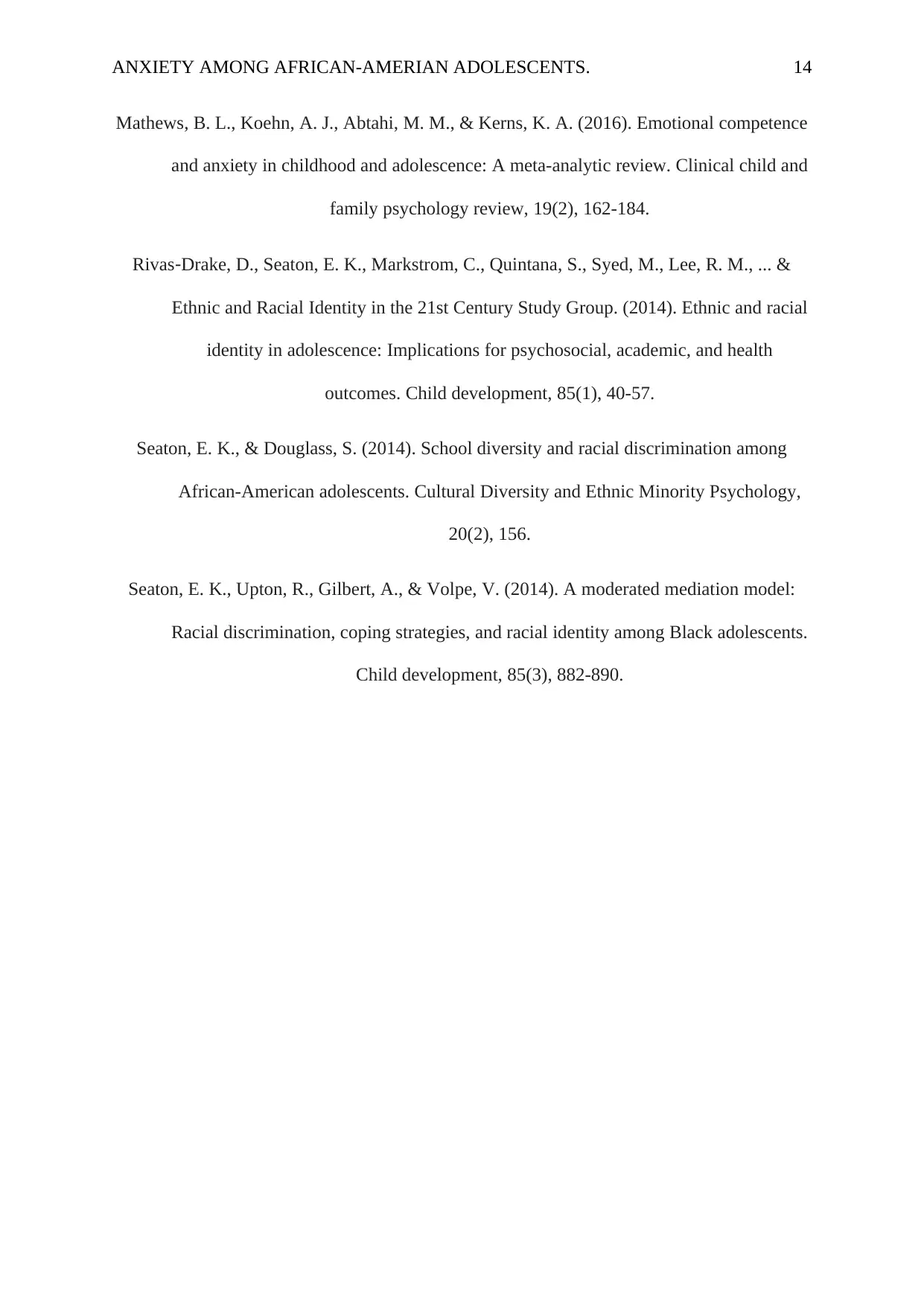
ANXIETY AMONG AFRICAN-AMERIAN ADOLESCENTS. 14
Mathews, B. L., Koehn, A. J., Abtahi, M. M., & Kerns, K. A. (2016). Emotional competence
and anxiety in childhood and adolescence: A meta-analytic review. Clinical child and
family psychology review, 19(2), 162-184.
Rivas‐Drake, D., Seaton, E. K., Markstrom, C., Quintana, S., Syed, M., Lee, R. M., ... &
Ethnic and Racial Identity in the 21st Century Study Group. (2014). Ethnic and racial
identity in adolescence: Implications for psychosocial, academic, and health
outcomes. Child development, 85(1), 40-57.
Seaton, E. K., & Douglass, S. (2014). School diversity and racial discrimination among
African-American adolescents. Cultural Diversity and Ethnic Minority Psychology,
20(2), 156.
Seaton, E. K., Upton, R., Gilbert, A., & Volpe, V. (2014). A moderated mediation model:
Racial discrimination, coping strategies, and racial identity among Black adolescents.
Child development, 85(3), 882-890.
Mathews, B. L., Koehn, A. J., Abtahi, M. M., & Kerns, K. A. (2016). Emotional competence
and anxiety in childhood and adolescence: A meta-analytic review. Clinical child and
family psychology review, 19(2), 162-184.
Rivas‐Drake, D., Seaton, E. K., Markstrom, C., Quintana, S., Syed, M., Lee, R. M., ... &
Ethnic and Racial Identity in the 21st Century Study Group. (2014). Ethnic and racial
identity in adolescence: Implications for psychosocial, academic, and health
outcomes. Child development, 85(1), 40-57.
Seaton, E. K., & Douglass, S. (2014). School diversity and racial discrimination among
African-American adolescents. Cultural Diversity and Ethnic Minority Psychology,
20(2), 156.
Seaton, E. K., Upton, R., Gilbert, A., & Volpe, V. (2014). A moderated mediation model:
Racial discrimination, coping strategies, and racial identity among Black adolescents.
Child development, 85(3), 882-890.
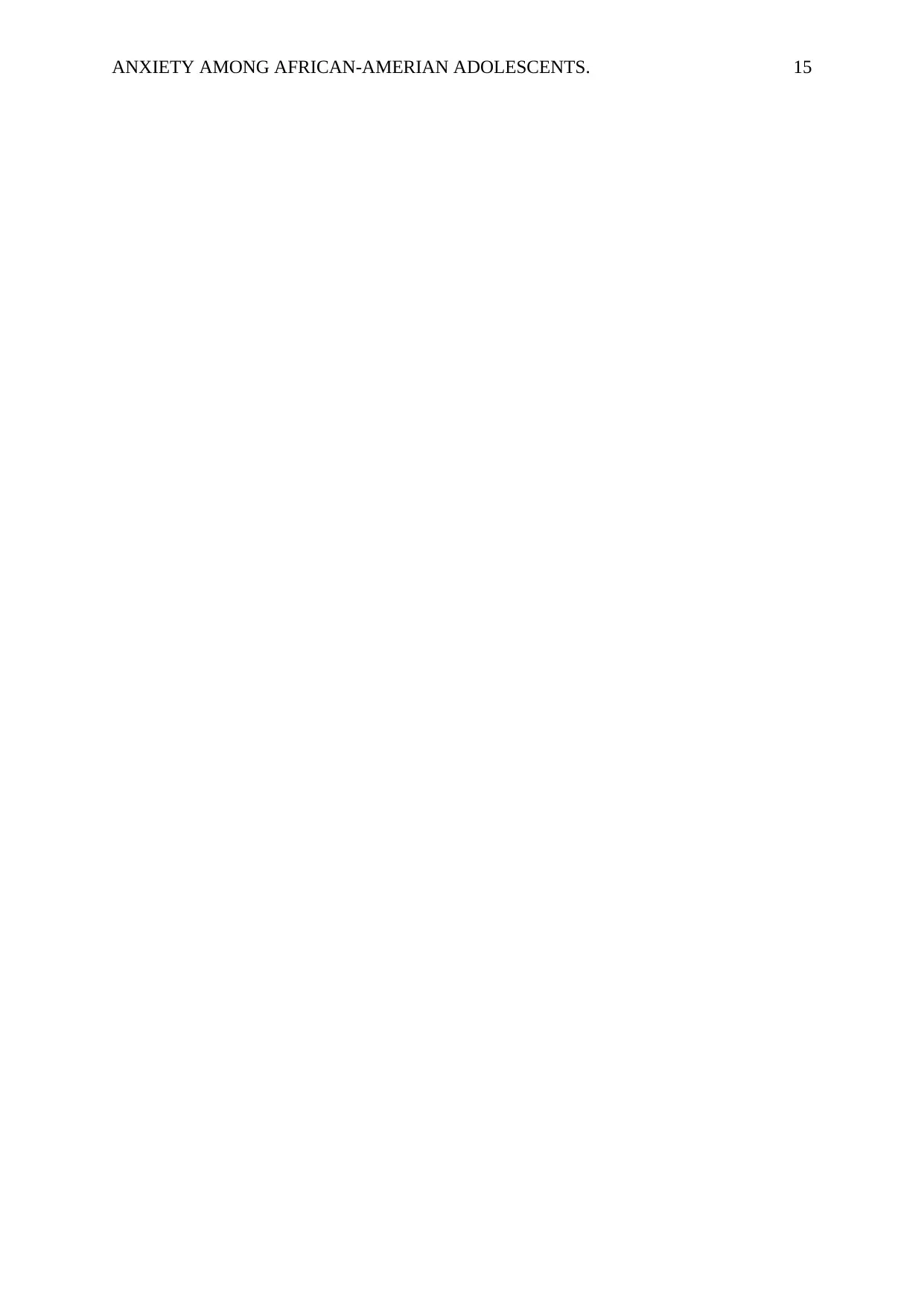
ANXIETY AMONG AFRICAN-AMERIAN ADOLESCENTS. 15
1 out of 15
Related Documents
Your All-in-One AI-Powered Toolkit for Academic Success.
+13062052269
info@desklib.com
Available 24*7 on WhatsApp / Email
![[object Object]](/_next/static/media/star-bottom.7253800d.svg)
Unlock your academic potential
© 2024 | Zucol Services PVT LTD | All rights reserved.





